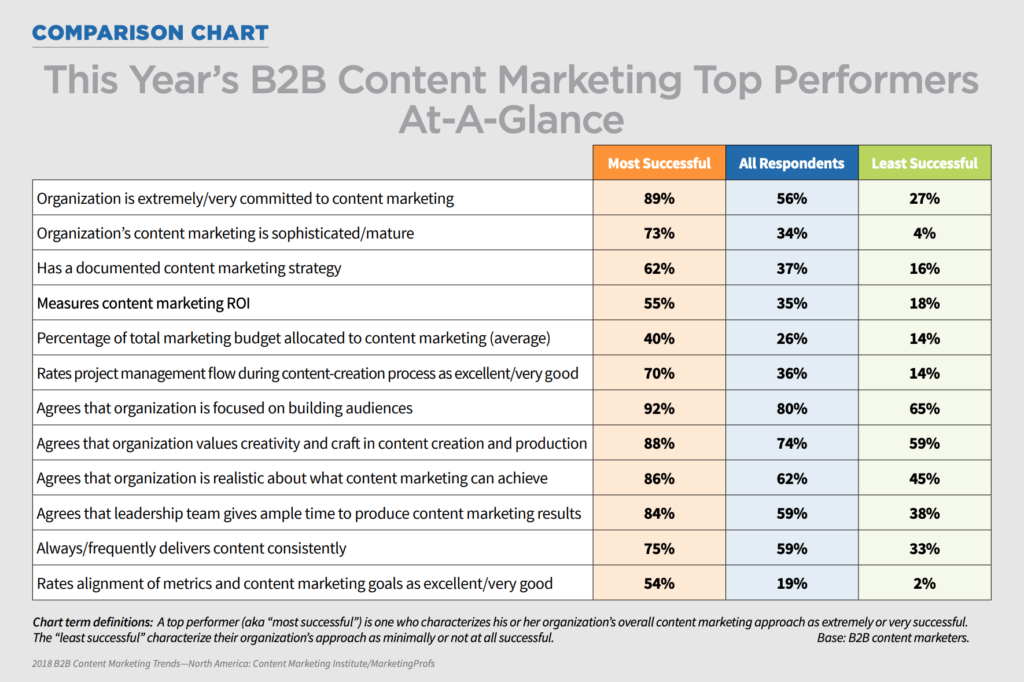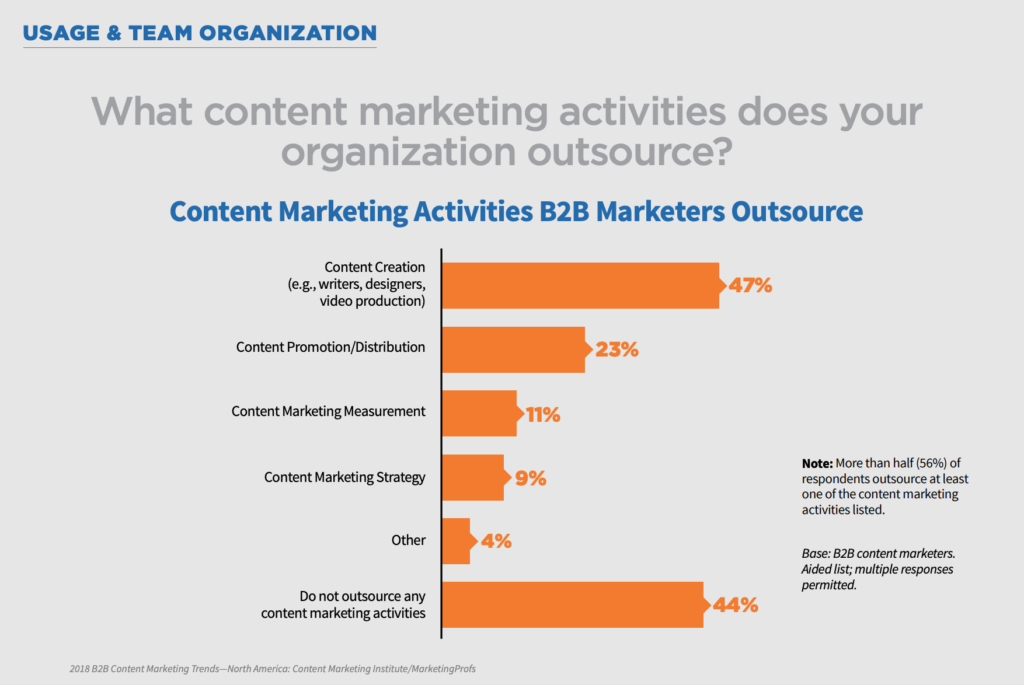Each year Content Marketing Institute (CMI) shares insights gleaned from hundreds of hours of research focused on B2B organisations. Together with MarketingProfs and Brightcove, they released their B2B Content Marketing 2018: Benchmarks, Budgets and Trends – North America, which continues to be among the most cited research about B2B content marketing around the globe.
There’s a lot of information contained inside this report, so we’ve put highlighted the most fascinating points in this quick post below.
Who was involved in the report
Data was taken from 870 North American for-profit marketers whose businesses revolved mostly around selling products and services to other businesses. The survey was conducted between June and July of 2017.
Who is using content marketing and how successful is it
Over half (56 per cent) of the B2B marketing respondents said that their organisations are either “very” or “extremely” committed to content marketing. This is interesting considering less than one quarter (24 per cent) of respondents felt that their organisation was either “very” or “extremely” successful in content marketing.
Only 18 per cent felt that their content marketing was a lot more successful than one year previous.

Creating and distributing content
It turns out that a lot of organisations are “winging it” when it comes to creating content for their organisation.
According to the report, 37 per cent of B2B marketers claimed to have a documented content marketing strategy, and 38 per cent said that they didn’t have any documented content marketing strategy, which makes it incredibly difficult to plan, delegate and distribute content to audiences effectively (this explains why only 59 per cent of B2B marketers stated they consistently delivered content!). This immediately reduces the value of an organisation’s content marketing efforts.
Here are the leading types of content being used for content marketing:
- Social media (used by 94 per cent of organisations)
- Case studies (used by 73 per cent of organisations)
- Videos (used by 72 per cent of organisations)
- White papers/e-books (71 per cent of organisations)
Emails were the leading format for distributing content. Social media platforms were used by 92 per cent of B2B marketers for distributing content. The breakdown between the types of social media showed that 97 per cent of organisations used LinkedIn, 87 per cent used Twitter, and 86 per cent used Facebook.
As it turns out, creativity and craft are highly valued by B2B marketers. B2B respondents (74 per cent) and top performers (88 per cent) shared that both factors were important in the production of marketing content. Top performers are defined as a marketer who sees his or her organisation’s overall content marketing approach as either very or extremely successful.
Building audiences a leading goal
Of the BB2B marketers involved in the survey, 80 per cent agreed that they were focused on building audiences. This increased to 92 per cent for the top performers and this, according to Content Marketing Institute’s research director Lisa Murton Beets, represents an 18 per cent year-over-year increase.
Tracking content marketing success
Some of the lowest numbers were hit when it came to aligning analytical data and content marketing goals. A mere 19 per cent of average B2B marketers said that they did just that, while an abysmal 2 per cent of “least successful” marketers (those who characterise their organisation’s approach as either minimal or unsuccessful) did so.
Of the top performing B2B markets, 54 per cent stated their organisation’s ability to have matched their metrics to their content marketing goals as “very good” or “excellent”.
It comes as no surprise then that 55 per cent of top performing B2B marketers measures the return on their content marketing investment. This is in comparison to 35 per cent of average B2B marketers and 18 per cent of the least successful B2B marketers.
Top performers vs. typical respondents
Another interesting takeaway from the study is how a so-called “average” B2B marketer stacks up against a “top performer”.
We already touched upon the fact that 37 per cent of B2B marketers have a documented marketing strategy. When it comes to top performers, this number almost doubles to 62 per cent having a documented content marketing strategy. This proves that if a B2B organisation wants to have an edge, there have to be solid processes in place to create and distribute content.
It’s no surprise then that 36 per cent of average B2B marketers versus 70 per cent of top performers rated the project management flow for the creation of content as “very good” or “excellent”.
The majority of respondents agree that their overall content marketing approach had improved from last year when 63 per cent of average respondents and 78 per cent of top performers shared that their marketing approach was more successful than it had been a year ago.
Creativity, consistency and coordination behind successful content marketing campaigns.
The top performers involved in the study had many things in common, including a set content marketing process and schedule stacked with creative and engaging posts.
We know that creating premium content for your B2B business can be an overwhelming task for which many simply don’t have the time, drive, or desire to take on. But one thing we do know for certain is that the right content will deliver the right results for your business, whether that’s building an audience, growing brand awareness, or increasing sales.
Outsourcing Content Creation
One of the most telling results of the survey was the number of businesses (44%) that choose to outsource their content creation. They are the types of companies who are focused on their core business and competencies.

Need help?

Together with my team of superb native English speaking writers (from North America, the UK, and Australia) can create your written content for you, in your voice, whether it be an opt-in report, blog post, case study or landing pages.
I invite you to contact me directly today to discuss just what you need, or alternatively, you can complete my Quick Quote Form.
Kerry

What are some common examples of B2B businesses? I don’t know too much about this. Is this like medical supplies, restaurant supplies, etc.?
Thanks for the question – it reminds me that I should always spell out the meanings of acronyms I use. B2B means Business to Business, rather than, for instance Business to Consumer. B2B is when one business markets/sells to other businesses. Examples are wholesalers selling to retailers as is the case with a medical equipment manufacturer selling to a hospital, a scaffolding importer or manufacturer marketing to construction companies, or an employment agency marketing to employers. Let me know if you need more examples.
Thank you for the explanation!
Is it easy for a B2B company to advertise via Facebook? How do they target their audience? Just curious…
I’m not an expert on Facebook advertising Carol, but I know that when I boost some of the posts on my FB business page I am able to segment the target audience by profession. Perhaps another reader would be able to give some input here.
The settings they have on FB now are pretty good when it comes to ad targeting. My friend uses the profession option as Kerry mentioned, as well as specific interests, which has yielded positive results in B2B advertising.
Great examples for B2B content marketing, this was informative!